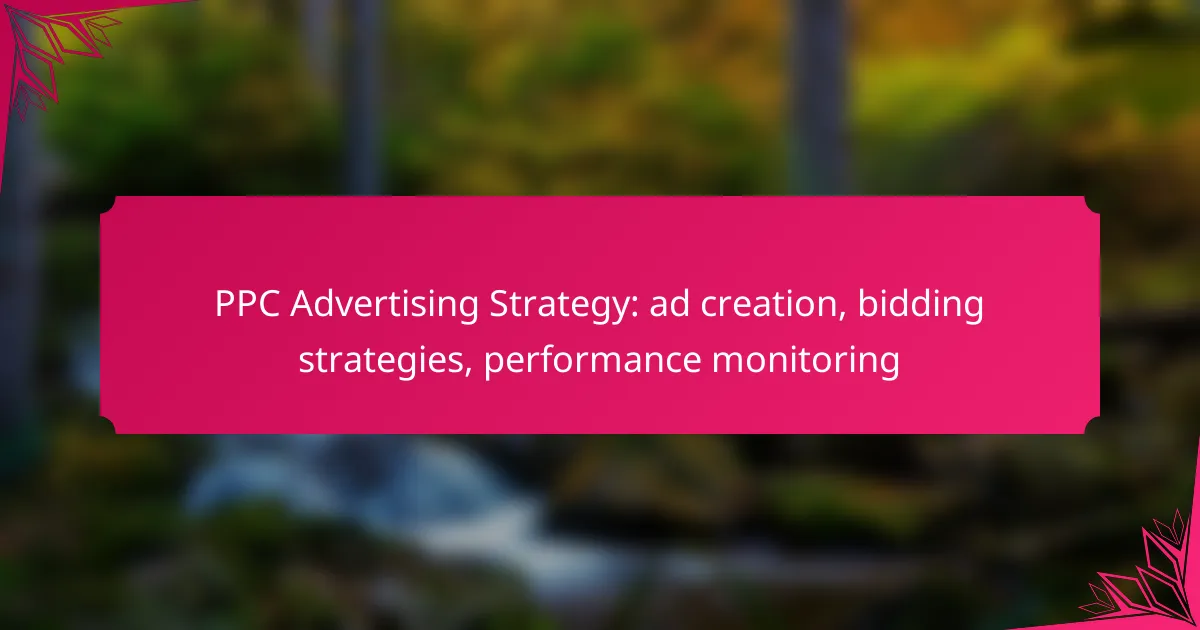PPC advertising is a powerful tool for driving targeted traffic and maximizing return on investment. By focusing on effective ad creation, strategic bidding, and continuous performance monitoring, businesses can enhance their visibility and achieve their marketing goals. Key elements include selecting the right keywords, crafting compelling ad copy, and employing appropriate bidding strategies tailored to specific campaign objectives.
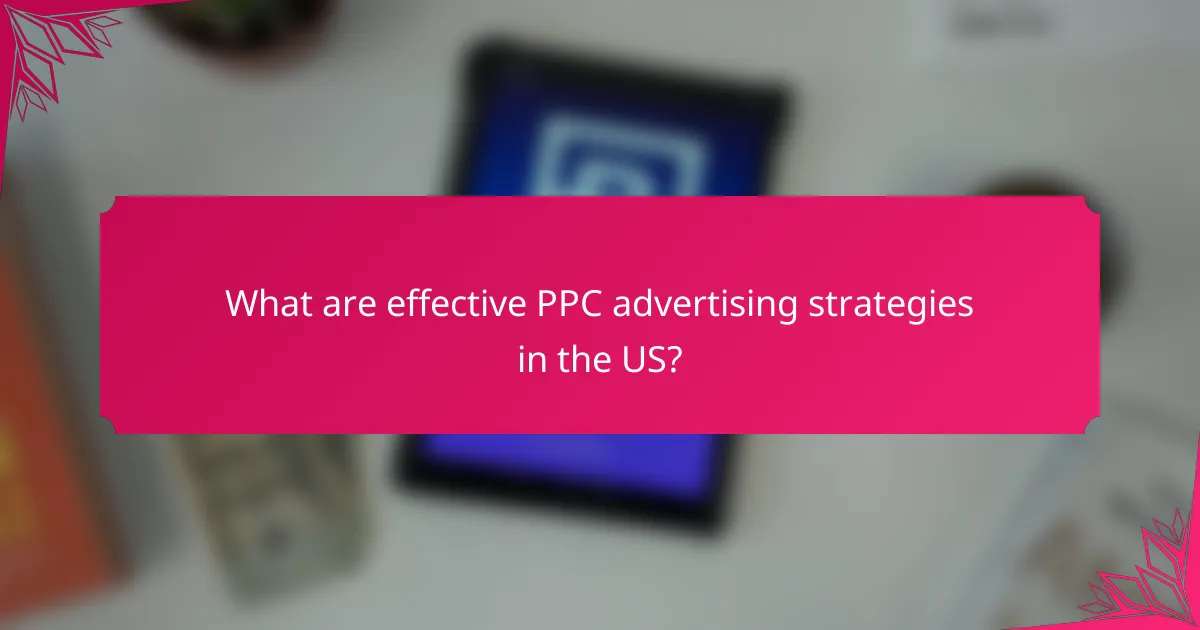
What are effective PPC advertising strategies in the US?
Effective PPC advertising strategies in the US focus on maximizing ad visibility and return on investment through targeted approaches. Key strategies include selecting the right keywords, optimizing ad copy, ensuring landing page relevance, utilizing ad extensions, and implementing geo-targeting options.
Targeted keyword selection
Targeted keyword selection is crucial for driving relevant traffic to your ads. Start by researching keywords that align with your business goals and customer intent, using tools like Google Keyword Planner. Aim for a mix of broad and long-tail keywords to capture various search queries.
Consider the competition and search volume for each keyword. Focus on keywords with a good balance of high search volume and manageable competition to optimize your ad spend effectively.
Ad copy optimization
Ad copy optimization involves crafting compelling and relevant messages that resonate with your target audience. Use clear language, highlight unique selling points, and include a strong call to action to encourage clicks. Testing different versions of ad copy can help identify what works best.
Incorporate targeted keywords naturally into your ad copy to improve relevance and Quality Score. This can lead to lower costs per click and better ad placements.
Landing page relevance
Landing page relevance is essential for converting clicks into actions. Ensure that your landing page content aligns with the ad copy and keywords used in your PPC campaign. A seamless user experience can significantly improve conversion rates.
Optimize landing pages for speed and mobile responsiveness. Aim for loading times under three seconds and ensure that the design is user-friendly across devices to reduce bounce rates.
Utilizing ad extensions
Utilizing ad extensions enhances your PPC ads by providing additional information and increasing visibility. Options include site link extensions, call extensions, and location extensions, which can improve click-through rates by offering more context to potential customers.
Implementing ad extensions is generally straightforward and can be done through your PPC platform. Monitor their performance to determine which extensions yield the best results and adjust accordingly.
Geo-targeting options
Geo-targeting options allow you to focus your PPC campaigns on specific geographic areas, enhancing relevance for local customers. This strategy is particularly effective for businesses with physical locations or those offering services in certain regions.
Utilize geo-targeting settings in your PPC platform to specify locations down to the city or even zip code level. This can help optimize ad spend and improve conversion rates by reaching the right audience in the right place.
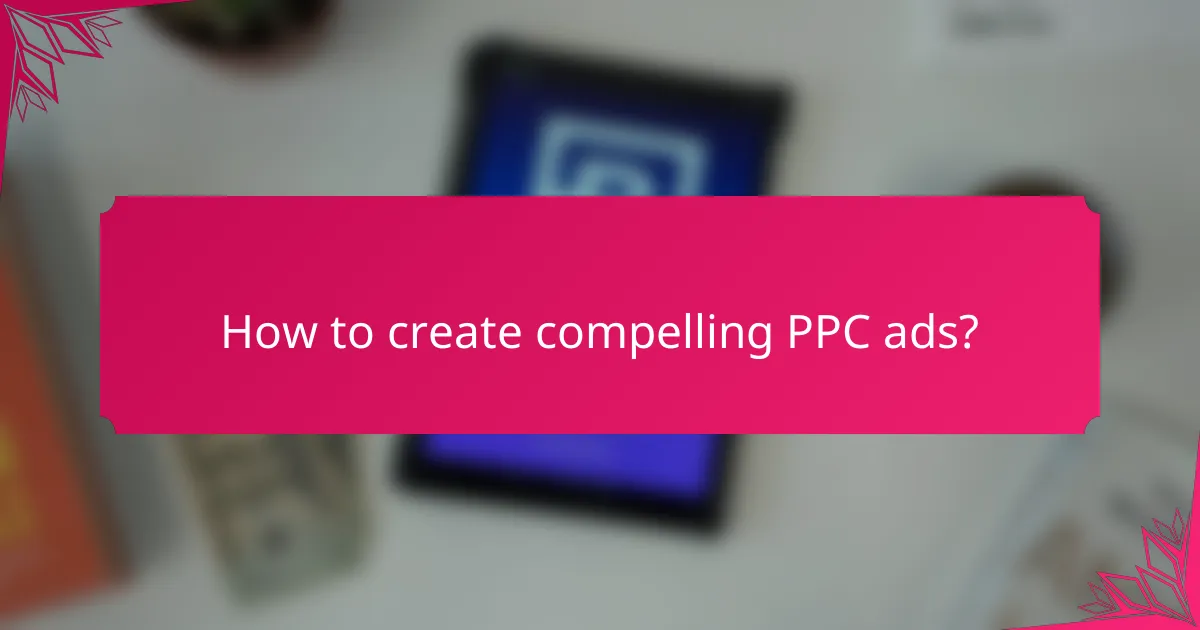
How to create compelling PPC ads?
Creating compelling PPC ads involves crafting messages that resonate with your target audience while clearly communicating the benefits of your offering. Focus on value, urgency, and clarity to drive clicks and conversions.
Clear value propositions
A clear value proposition articulates why a customer should choose your product or service over competitors. It should highlight unique features, benefits, or savings, making it immediately apparent what sets you apart.
Consider using phrases that emphasize cost savings, quality, or exclusivity. For example, “Save 20% on your first purchase” or “Get free shipping on orders over $50” can effectively draw attention.
Strong call-to-action
A strong call-to-action (CTA) prompts users to take immediate action, such as “Buy Now” or “Sign Up Today.” The language should be direct and create a sense of urgency, encouraging users to click on your ad.
Using action-oriented verbs and clear instructions can significantly enhance engagement. Phrases like “Limited Time Offer” or “Join Thousands of Satisfied Customers” can motivate users to act quickly.
Utilizing A/B testing
A/B testing involves creating two versions of an ad to determine which performs better. This method allows you to experiment with different headlines, images, or CTAs, providing valuable insights into what resonates with your audience.
Start by changing one element at a time to isolate its impact. For instance, test two different headlines to see which one generates more clicks. Analyze the results to refine your ads continuously.
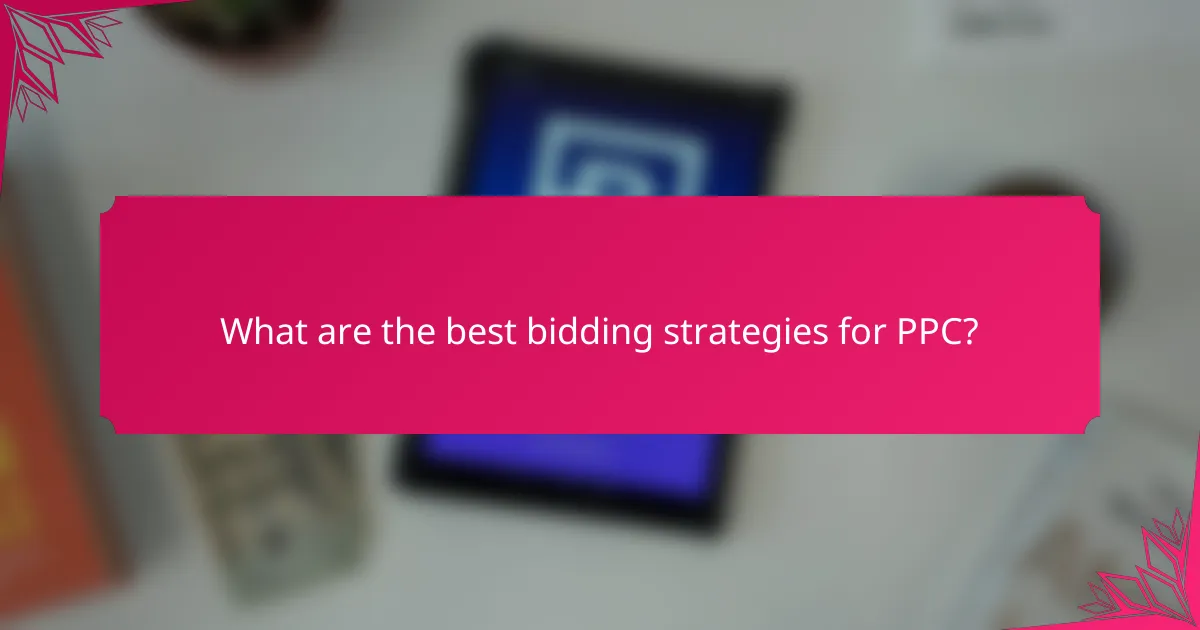
What are the best bidding strategies for PPC?
The best bidding strategies for PPC (Pay-Per-Click) advertising depend on your campaign goals and budget. Effective strategies include Manual CPC, Enhanced CPC, Target CPA, and Maximize Conversions, each offering unique advantages and considerations for optimizing ad spend.
Manual CPC bidding
Manual CPC bidding allows advertisers to set their own maximum cost-per-click for each keyword or ad group. This strategy provides full control over bids, making it suitable for campaigns where specific keywords are critical for success.
When using Manual CPC, regularly monitor performance and adjust bids based on the effectiveness of keywords. A common approach is to increase bids for high-performing keywords while reducing bids for those that underperform.
Enhanced CPC bidding
Enhanced CPC (eCPC) automatically adjusts your manual bids based on the likelihood of conversion. This strategy uses historical data to increase bids for clicks that are more likely to result in sales, while lowering bids for less promising clicks.
eCPC is beneficial for advertisers who want to maintain control over their bids while leveraging automated adjustments. It’s important to monitor the overall performance to ensure that the adjustments align with your campaign goals.
Target CPA bidding
Target CPA (Cost Per Acquisition) bidding sets bids to achieve a specific cost per conversion. This strategy is ideal for advertisers focused on maximizing conversions within a defined budget.
When implementing Target CPA, it’s crucial to set a realistic CPA goal based on historical data. Regularly review and adjust your target CPA as needed to ensure it aligns with your overall marketing objectives and return on investment.
Maximize conversions bidding
Maximize conversions bidding automatically sets bids to get the most conversions for your budget. This strategy is particularly effective for advertisers looking to increase the volume of conversions without a specific cost per acquisition target.
To use this strategy effectively, ensure you have sufficient conversion data for the algorithm to optimize bids. Monitor performance closely, as this approach can lead to higher spending if not managed properly, especially in competitive markets.
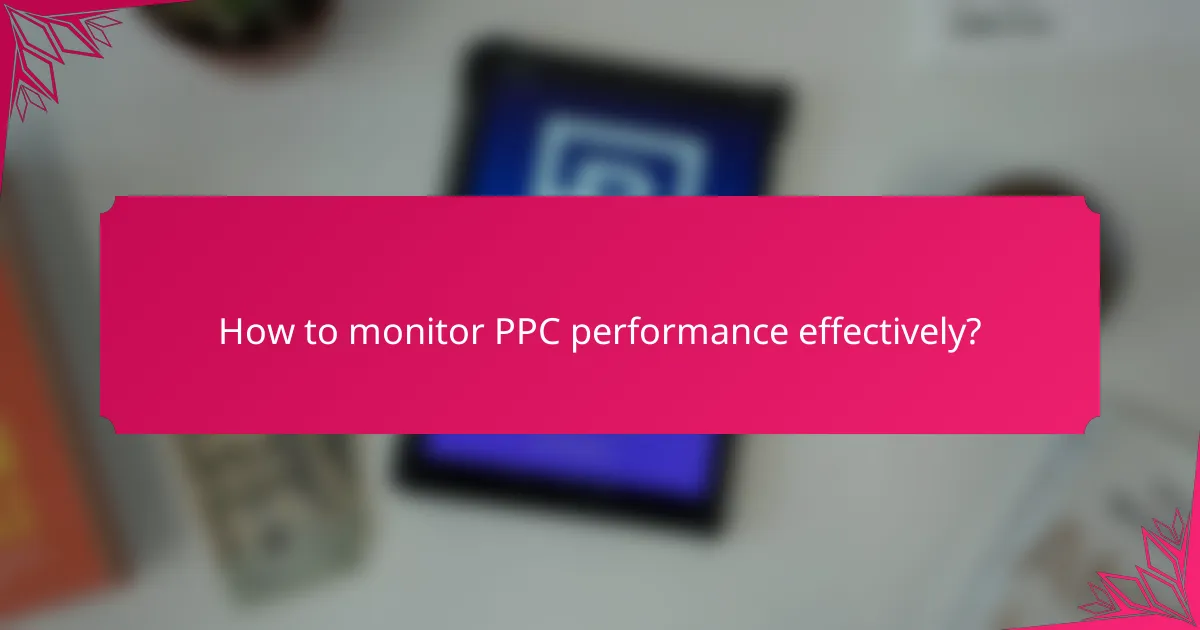
How to monitor PPC performance effectively?
Monitoring PPC performance effectively involves tracking key metrics that indicate how well your ads are performing. Regular analysis of these metrics allows for timely adjustments to improve campaign outcomes.
Key performance indicators (KPIs)
Key performance indicators (KPIs) are essential metrics that help evaluate the success of your PPC campaigns. Common KPIs include click-through rate (CTR), cost per click (CPC), conversion rate, and return on ad spend (ROAS).
For instance, a high CTR indicates that your ads are engaging, while a low CPC suggests efficient spending. Aim for a conversion rate of around 2-5% as a benchmark, but this can vary by industry.
Utilizing Google Ads reports
Google Ads provides various reports that help you analyze campaign performance. The Overview report gives a snapshot of key metrics, while the Search Terms report shows which queries triggered your ads.
Regularly reviewing these reports can help identify trends and areas for improvement. For example, if certain keywords have a high CPC but low conversion rates, consider adjusting your bidding strategy or pausing those keywords.
Conversion tracking setup
Setting up conversion tracking is crucial for measuring the effectiveness of your PPC campaigns. This involves adding a tracking code to your website that records when users complete desired actions, such as making a purchase or signing up for a newsletter.
To set up conversion tracking in Google Ads, navigate to the “Tools & Settings” menu, select “Conversions,” and follow the prompts to create a new conversion action. Ensure that you test the tracking to confirm it captures data accurately.
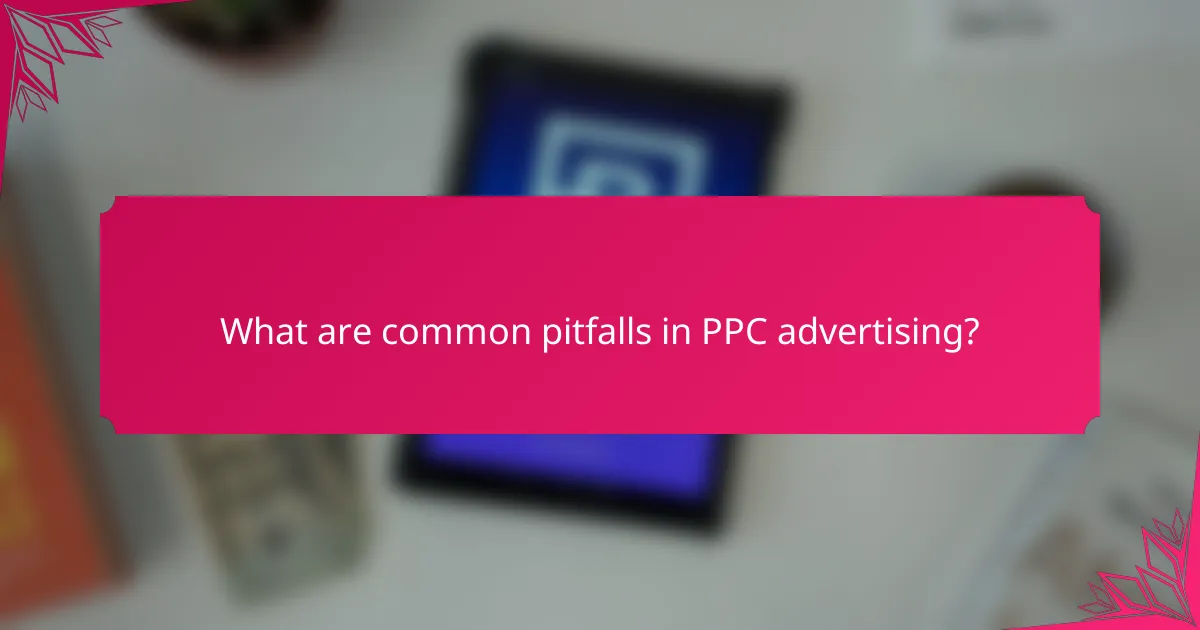
What are common pitfalls in PPC advertising?
Common pitfalls in PPC advertising include failing to utilize negative keywords and neglecting mobile optimization. These mistakes can lead to wasted budgets and missed opportunities for effective audience targeting.
Ignoring negative keywords
Ignoring negative keywords can significantly impact the efficiency of your PPC campaigns. Negative keywords prevent your ads from showing up for irrelevant searches, which helps to refine your audience and reduce wasted clicks.
To effectively use negative keywords, regularly analyze your search term reports to identify terms that are generating clicks but not conversions. For instance, if you sell premium shoes, you might want to add “cheap” as a negative keyword to avoid attracting bargain hunters.
As a best practice, maintain a list of negative keywords and update it frequently to ensure your ads reach the most relevant audience, ultimately improving your return on investment.
Overlooking mobile optimization
Overlooking mobile optimization can lead to poor user experiences and lower conversion rates. With a significant portion of online traffic coming from mobile devices, ensuring your ads and landing pages are mobile-friendly is crucial.
To optimize for mobile, use responsive design for your landing pages and ensure that your ad copy is concise and engaging. Test your ads on various devices to confirm they display correctly and load quickly, ideally within a few seconds.
Additionally, consider adjusting your bidding strategies to allocate more budget to mobile users, as they may have different behaviors and preferences compared to desktop users. This can enhance your campaign’s overall performance and effectiveness.
